Variability of Summer Drought and Heatwave Events in Northeast China
Abstract
1. Introduction
2. Materials and Methods
2.1. Study Area and Data Sources
2.2. Methodology for Calculation of SPI and STI
2.3. STPI
2.3.1. Construction of Indicators for Drought and High Temperatures
2.3.2. Construction of STPI
2.4. Mann–Kendall Trend Analysis and Sen’s Slope Estimation
2.5. Hit Rate
2.6. Compound Dry and Heat Frequency
3. Results
3.1. Drought Analysis
3.1.1. Drought Temporal Trend
3.1.2. Spatial Distribution of Drought Events
3.2. High-Temperature Analysis
3.2.1. High-Temperature Temporal Trend
3.2.2. Spatial Distribution of High-Temperature Events
3.3. STPI Analysis
3.3.1. Temporal Trend of STPI
3.3.2. Spatial Distribution of STPI
3.4. Hit Rate Analysis of STPI in Northeast China
3.5. The Applicability of STPI in Northeast China
4. Discussion
5. Conclusions
Author Contributions
Funding
Institutional Review Board Statement
Informed Consent Statement
Data Availability Statement
Acknowledgments
Conflicts of Interest
References
- Robinson, A.; Lehmann, J.; Barriopedro, D.; Rahmstorf, S.; Coumou, D. Increasing heat and rainfall extremes now far outside the historical climate. npj Clim. Atmos. Sci. 2021, 4, 45. [Google Scholar] [CrossRef]
- Min, R.; Gu, X.; Guan, Y.; Zhang, X. Increasing likelihood of global compound hot-dry extremes from temperature and runoff during the past 120 years. J. Hydrol. 2023, 621, 129553. [Google Scholar] [CrossRef]
- Ghanbari, M.; Arabi, M.; Georgescu, M.; Broadbent, A.M. The role of climate change and urban development on compound dry-hot extremes across US cities. Nat. Commun. 2023, 14, 3509. [Google Scholar] [CrossRef] [PubMed]
- Han, Z.; Zhang, H.; Fu, J.; Wang, Z.; Duan, L.; Zhang, W.; Li, Z. Dynamic assessment of the impact of compound dry-hot conditions on global terrestrial water storage. Remote Sens. Environ. 2024, 315, 114428. [Google Scholar] [CrossRef]
- Fan, X.; Zhang, Y.; Shi, K.; Peng, J.; Liu, Y.; Zhou, Y.; Liu, Y.; Zhu, Q.; Song, C.; Wan, R.; et al. Surging compound drought–heatwaves underrated in global soils. Proc. Natl. Acad. Sci. USA 2024, 121, e2410294121. [Google Scholar] [CrossRef] [PubMed]
- Zhao, W. Extreme weather and climate events in China under changing climate. Natl. Sci. Rev. 2020, 7, 938–943. [Google Scholar] [CrossRef] [PubMed]
- Pescaroli, G.; Alexander, D. Understanding Compound, Interconnected, Interacting, and Cascading Risks: A Holistic Framework. Risk Anal. 2018, 38, 2245–2257. [Google Scholar] [CrossRef] [PubMed]
- Sun, Y.; Zhang, X.; Shi, X.; Zhang, P. The economic impact of climate risks in China: Evidence from 47-sector panel data, 2000–2014. Nat. Hazards 2019, 95, 289–308. [Google Scholar] [CrossRef]
- Wu, X.; Yang, Y.; Jiang, D. Dramatic increase in the probability of 2006-like compound dry and hot events over Southwest China under future global warming. Weather Clim. Extrem. 2023, 41, 100592. [Google Scholar] [CrossRef]
- Wu, X.; Hao, Z.; Hao, F.; Singh, V.P.; Zhang, X. Dry-hot magnitude index: A joint indicator for compound event analysis. Environ. Res. Lett. 2019, 14, 064017. [Google Scholar] [CrossRef]
- Van den Hurk, B.J.J.M.; Baldissera Pacchetti, M.; Boere, E.; Ciullo, A.; Coulter, L.; Dessai, S.; Ercin, E.; Goulart, H.M.D.; Hamed, R.; Hochrainer-Stigler, S.; et al. Climate impact storylines for assessing socio-economic responses to remote events. Clim. Risk Manag. 2023, 40, 100500. [Google Scholar] [CrossRef]
- Sun, H.; Sun, X.; Chen, J.; Deng, X.; Yang, Y.; Qin, H.; Chen, F.; Zhang, W. Different types of meteorological drought and their impact on agriculture in Central China. J. Hydrol. 2023, 627, 130423. [Google Scholar] [CrossRef]
- Sattar, M.N.; Lee, J.; Shin, J.; Kim, T. Probabilistic Characteristics of Drought Propagation from Meteorological to Hydrological Drought in South Korea. Water Resour. Manag. 2019, 33, 2439–2452. [Google Scholar] [CrossRef]
- Shiau, J. Causality-based drought propagation analyses among meteorological drought, hydrologic drought, and water shortage. Sci. Total Environ. 2023, 888, 164216. [Google Scholar] [CrossRef] [PubMed]
- Wilhite, D.A.; Glantz, M.H. Understanding the Drought Phenomenon: The Role of Definitions. Water Int. 1985, 10, 111–120. [Google Scholar] [CrossRef]
- Mishra, A.K.; Singh, V.P. A review of drought concepts. J. Hydrol. 2010, 391, 202–216. [Google Scholar] [CrossRef]
- Tabari, H.; Willems, P. Global risk assessment of compound hot-dry events in the context of future climate change and socioeconomic factors. npj Clim. Atmos. Sci. 2023, 6, 74. [Google Scholar] [CrossRef]
- Palmer, W.C. Meteorological Drought; US Weather Bureau: Washington, DC, USA, 1965; Volume 58, Research Paper No. 45.
- Mckee, T.B.; Doesken, N.J.; Kleist, J. The relationship of drought frequency and duration of time scales. In Proceedings of the 8th Conference on Applied Climatology, Anaheim, CA, USA, 17–23 January 1993. [Google Scholar]
- Hua, Y.; Qi, H.; Shu, Y.; Jin, Y.; Xue, B.; Zhi, H.; Jing, W. Analysis of Spatio-Temporal Evolution of the Boundary Temperature of Chimonophilous/Thermophilic Crops in Chinese Mainland Based on Site Data. Chin. J. Agrometeorol. 2023, 44, 85–95. [Google Scholar] [CrossRef]
- Li, J.; Wang, Z.; Wu, X.; Zscheischler, J.; Guo, S.; Chen, X. A standardized index for assessing sub-monthly compound dry and hot conditions with application in China. Hydrol. Earth Syst. Sci. 2021, 25, 1587–1601. [Google Scholar] [CrossRef]
- Wu, X.; Hao, Z.; Zhang, X.; Li, C.; Hao, F. Evaluation of severity changes of compound dry and hot events in China based on a multivariate multi-index approach. J. Hydrol. 2020, 583, 124508. [Google Scholar] [CrossRef]
- Xiao, H.; Zhuo, Y.; Pang, K.; Sun, H.; An, Z.; Zhang, X. Evaluation of Extreme Climate Indices over the Three Northeastern Provinces of China Based on CMIP6 Models Outputs. Water 2023, 15, 3895. [Google Scholar] [CrossRef]
- Ribeiro, A.F.S.; Russo, A.; Gouveia, C.M.; Páscoa, P.; Zscheischler, J. Risk of crop failure due to compound dry and hot extremes estimated with nested copulas. Biogeosciences 2020, 17, 4815–4830. [Google Scholar] [CrossRef]
- Zuo, D.; Hou, W.; Wu, H.; Yan, P.; Zhang, Q. Feasibility of Calculating Standardized Precipitation Index with Short-Term Precipitation Data in China. Atmosphere 2021, 12, 603. [Google Scholar] [CrossRef]
- Stagge, J.H.; Tallaksen, L.M.; Gudmundsson, L.; Van Loon, A.F.; Stahl, K. Candidate Distributions for Climatological Drought Indices (SPI and SPEI). Int. J. Climatol. 2015, 35, 4027–4040. [Google Scholar] [CrossRef]
- Zscheischler, J.; Michalak, A.M.; Schwalm, C.; Mahecha, M.D.; Huntzinger, D.N.; Reichstein, M.; Berthier, G.; Ciais, P.; Cook, R.B.; El-Masri, B.; et al. Impact of large-scale climate extremes on biospheric carbon fluxes: An intercomparison based on MsTMIP data. Glob. Biogeochem. Cycles 2014, 28, 585–600. [Google Scholar] [CrossRef]
- McKee, T.B.; Doesken, N.J.; Kleist, J. Drought Monitoring with Multiple Time Scales. In Proceedings of the 9th Conference on Applied Climatology, Dallas, TX, USA, 15–20 January 1995; pp. 233–236. [Google Scholar]
- Hosseinzadehtalaei, P.; Termonia, P.; Tabari, H. Projected changes in compound hot-dry events depend on the dry indicator considered. Commun. Earth Environ. 2024, 5, 220. [Google Scholar] [CrossRef]
- Zscheischler, J.; Seneviratne, S. Dependence of drivers affects risks associated with compound events. Sci. Adv. 2017, 3, e1700263. [Google Scholar] [CrossRef] [PubMed]
- Zhang, Q.; Yu, X.; Qiu, R.; Liu, Z.; Yang, Z. Evolution, severity, and spatial extent of compound drought and heat events in north China based on copula model. Agric. Water Manag. 2022, 273, 107918. [Google Scholar] [CrossRef]
- Hussain, B.; Qureshi, N.A.; Buriro, R.A.; Qureshi, S.S.; Pirzado, A.A.; Saleh, T.A. Interdependence between temperature and precipitation: Modeling using copula method toward climate protection. Model. Earth Syst. Environ. 2022, 8, 2753–2766. [Google Scholar] [CrossRef]
- Lazoglou, G.; Anagnostopoulou, C. Joint distribution of temperature and precipitation in the Mediterranean, using the Copula method. Theor. Appl. Climatol. 2019, 135, 1399–1411. [Google Scholar] [CrossRef]
- Nelsen, R.B. An Introduction to Copulas; Springer: New York, NY, USA, 2000. [Google Scholar]
- Yeo, I.K.; Johnson, R.A. A new family of power transformations to improve normality or symmetry. Biometrika 2000, 87, 954–959. [Google Scholar] [CrossRef]
- Ullah, H.; Akbar, M.; Khan, F.; Amjad, M. Performance evaluation of Standardized Copula-based Drought Index with Reconnaissance Drought Index and Standardized Precipitation Temperature Index using severity—Duration frequency curves over Balochistan, Pakistan. Int. J. Climatol. 2023, 43, 2465–2480. [Google Scholar] [CrossRef]
- Kang, Y.; Guo, E.; Wang, Y.; Bao, Y.; Bao, Y.; Naren, M.; Runa, A.; Gu, X.; Jin, L. Characterisation of compound dry and hot events in Inner Mongolia and their relationship with large-scale circulation patterns. J. Hydrol. 2022, 612, 128296. [Google Scholar] [CrossRef]
- Agbo, E.P.; Nkajoe, U.; Edet, C.O. Comparison of Mann–Kendall and Şen’s innovative trend method for climatic parameters over Nigeria’s climatic zones. Clim. Dyn. 2022, 60, 3385–3401. [Google Scholar] [CrossRef]
- Ahmad, I.; Tang, D.; Wang, T.; Wang, M.; Wagan, B. Precipitation Trends over Time Using Mann-Kendall and Spearman’s rho Tests in Swat River Basin, Pakistan. Adv. Meteorol. 2015, 2015, 431860. [Google Scholar] [CrossRef]
- Kendall, M.G.; Stuart, A.; Ord, J.K. The Advanced Theory of Statistics, Vol. 3. Technometrics 1947, 5, 525–528. [Google Scholar] [CrossRef]
- Brushett, B.A.; King, B.A.; Lemckert, C.J. Assessment of ocean forecast models for search area prediction in the eastern Indian Ocean. Ocean Modell. 2016, 97, 1–15. [Google Scholar] [CrossRef]
- Jang, J.; Yu, P.; Yeh, S.; Fu, J.; Huang, C. A probabilistic model for real-time flood warning based on deterministic flood inundation mapping. Hydrol. Process. 2012, 26, 1079–1089. [Google Scholar] [CrossRef]
- Ma, F.; Yuan, X.; Li, H. Dominant atmospheric circulation patterns associated with the rapid intensification of summer flash droughts in Eastern China. Sci. Total Environ. 2024, 957, 177416. [Google Scholar] [CrossRef] [PubMed]
- Dai, A. Increasing drought under global warming in observations and models. Nat. Clim. Change 2013, 3, 52–58. [Google Scholar] [CrossRef]
- He, X.; Gong, D. Interdecadal change in Western Pacific Subtropical High and climatic effects. J. Geog. Sci. 2002, 12, 202–209. [Google Scholar] [CrossRef]
- Lu, E.; Zeng, Y.; Luo, Y.; Ding, Y.; Zhao, W.; Liu, S.; Gong, L.; Jiang, Y.; Jiang, Z.; Chen, H. Changes of summer precipitation in China: The dominance of frequency and intensity and linkage with changes in moisture and air temperature. J Geophys. Res. Atmos. 2014, 119, 12575–12587. [Google Scholar] [CrossRef]
- Chen, W.; Lu, R. A decadal shift of summer surface air temperature over Northeast Asia around the mid-1990s. Adv. Atmos. Sci. 2014, 31, 735–742. [Google Scholar] [CrossRef]
- Han, D.; Yang, G.; Yan, D.; Fang, H. Spatial-temporal Feature Analysis of Drought and Flood in Northeast China in Recent 50 Years. Water Resour. Power 2014, 32, 5–8. [Google Scholar]
- Wu, X.; Hao, Z.; Hao, F.; Li, C.; Zhang, X. Spatial and Temporal Variations of Compound Droughts and Hot Extremes in China. Atmosphere 2019, 10, 95. [Google Scholar] [CrossRef]
- Gao, X.; Jiang, S.; Wang, S.; Tian, L.; Zhou, M. The division of precipitation change and its regional characteristics in Northeast China during 1961–2014. Chin. J. Ecol. 2016, 35, 1301–1307. [Google Scholar]
- Wang, W.; Zhang, Y.; Guo, B.; Ji, M.; Xu, Y. Compound Droughts and Heat Waves over the Huai River Basin of China: From a Perspective of the Magnitude Index. J. Hydrometeorol. 2021, 22, 3107–3119. [Google Scholar] [CrossRef]
- Hu, K.; Huang, G.; Qu, X.; Huang, R. The impact of Indian Ocean variability on high temperature extremes across the southern Yangtze River valley in late summer. Adv. Atmos. Sci. 2012, 29, 91–100. [Google Scholar] [CrossRef]
- Zhang, H.; Zhang, Q.; Yue, P.; Zhang, L.; Liu, Q.; Qiao, S.; Yan, P. Aridity over a semiarid zone in northern China and responses to the East Asian summer monsoon. J. Geophys. Res. Atmos. 2016, 121, 13901–13918. [Google Scholar] [CrossRef]
- Wang, L.; Chen, W.; Chen, Z.; Huang, G. Drought in Southwest China: A Review. Atmos. Oceanic Sci. Lett. 2015, 8, 339–344. [Google Scholar]
- Khedun, C.P.; Sohoulande, C.D.D. Probabilistic estimates of drought-induced yield loss in the Southeastern United States. Agric. Syst. 2025, 229, 104418. [Google Scholar] [CrossRef]

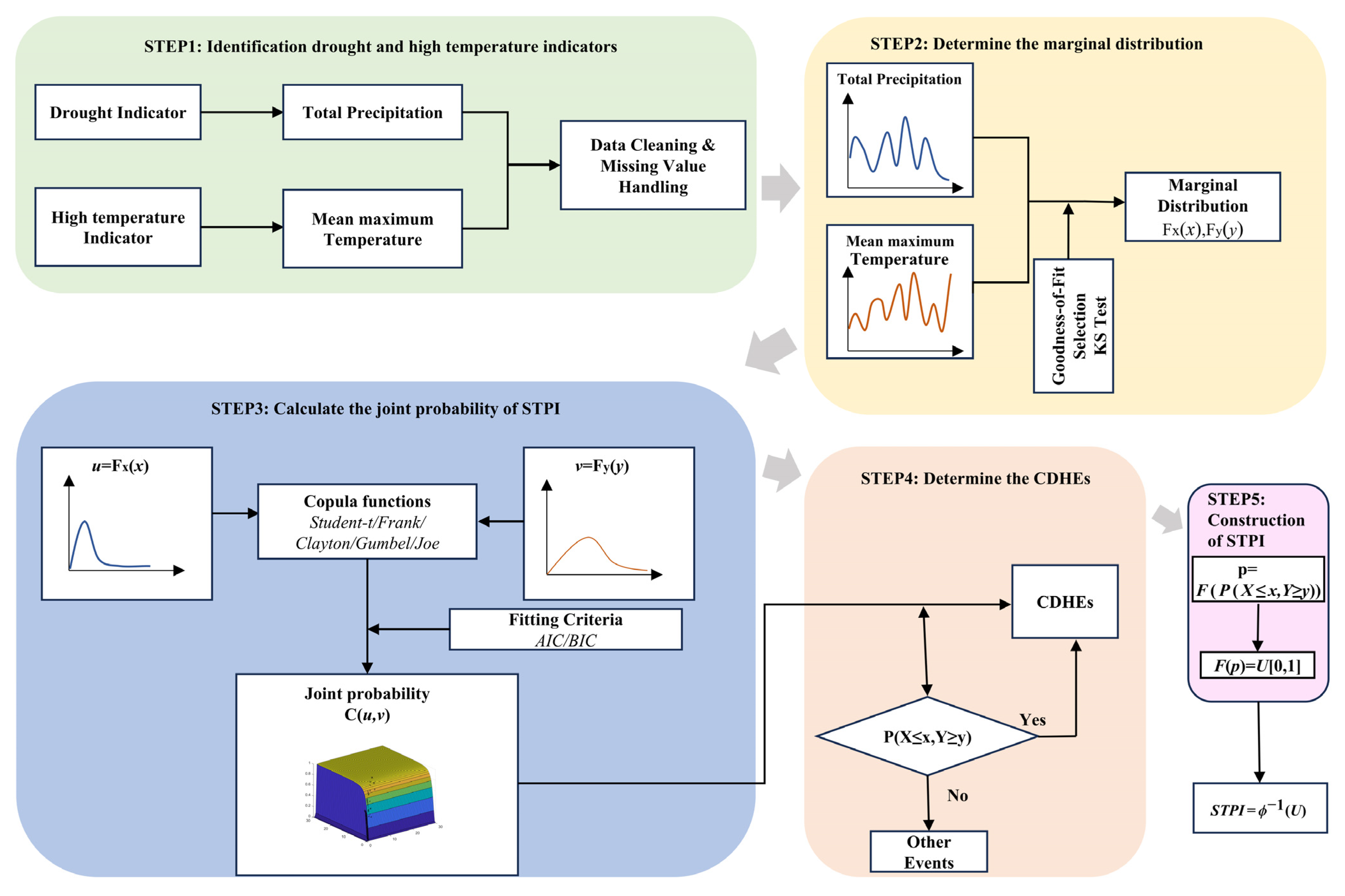
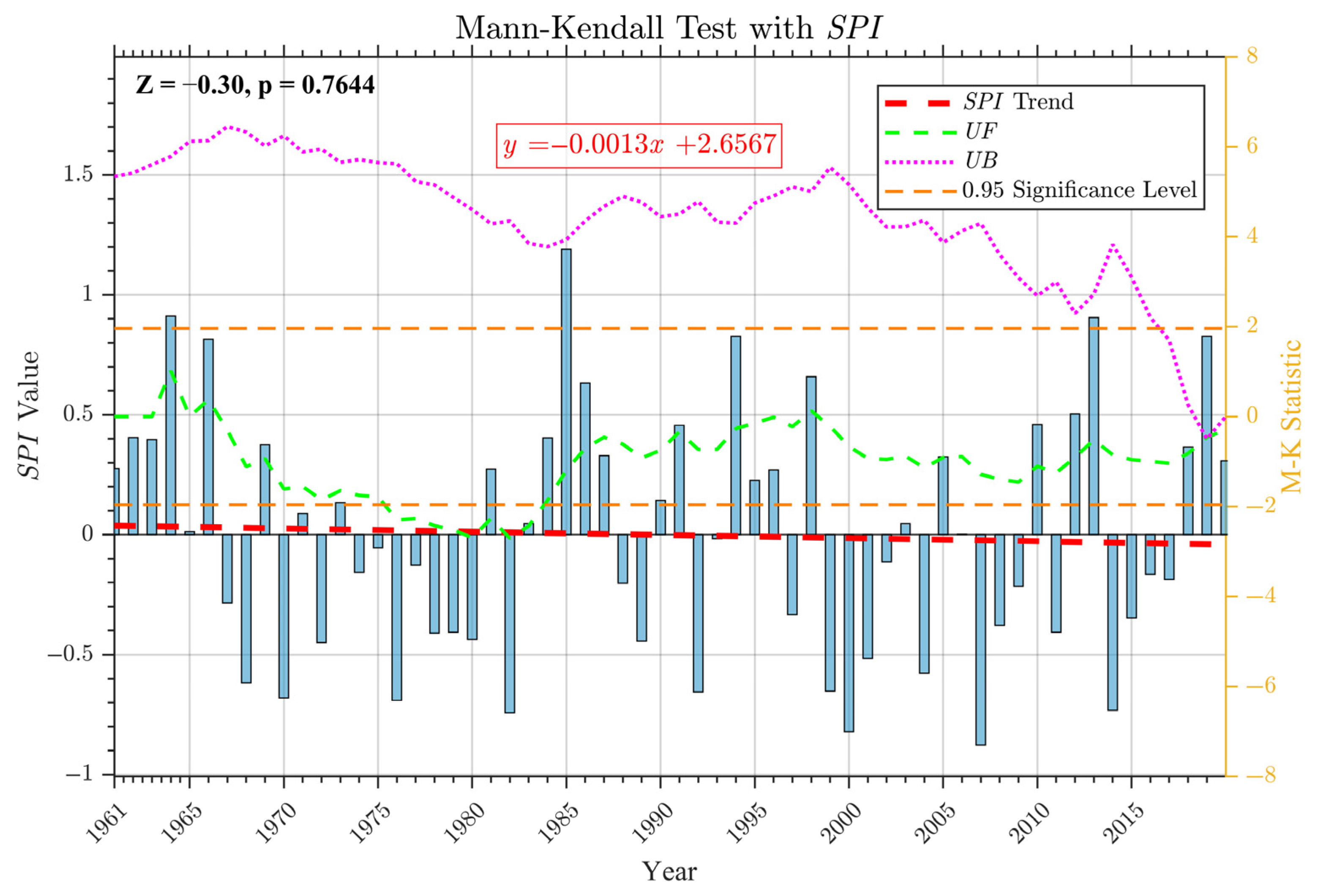
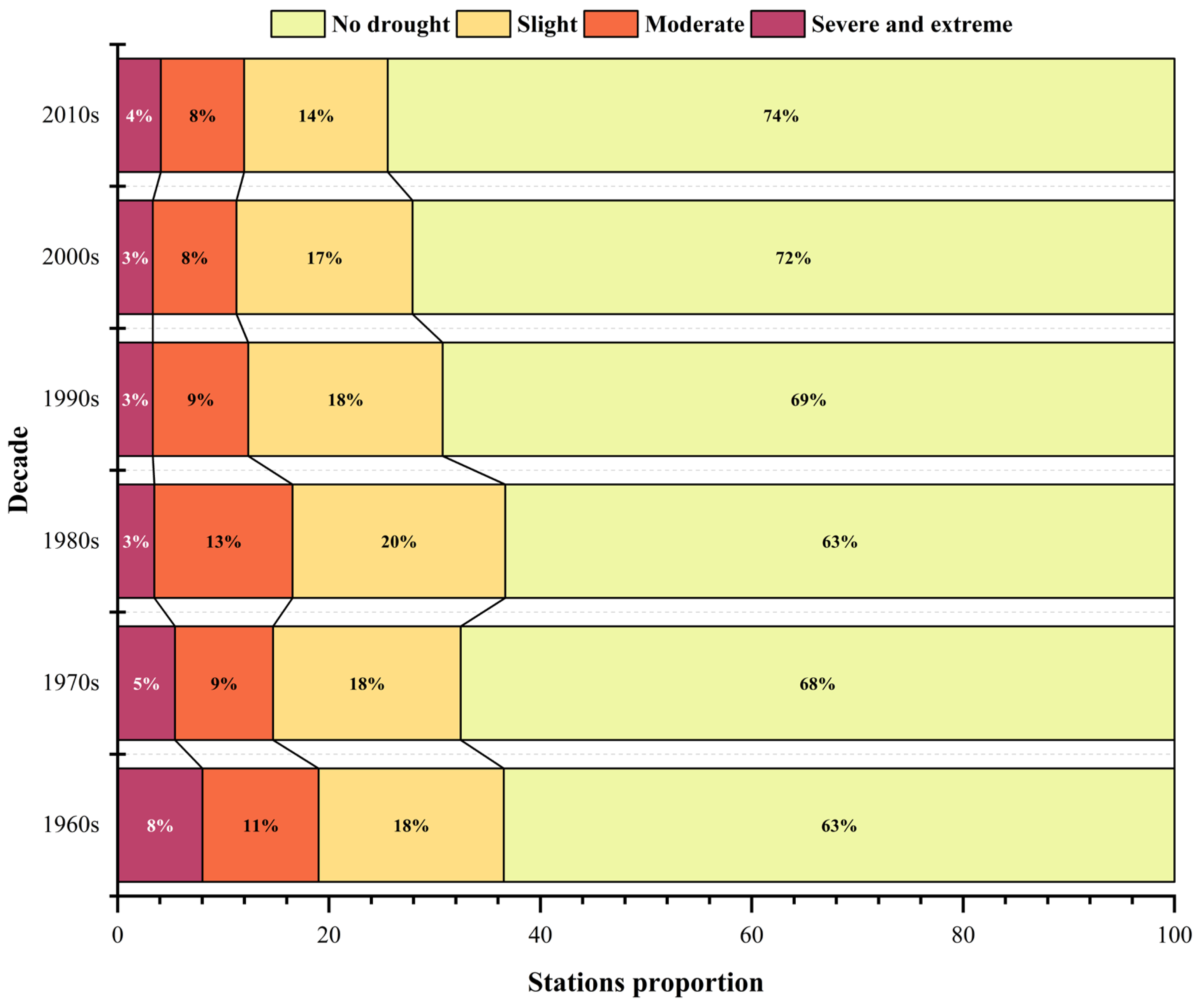
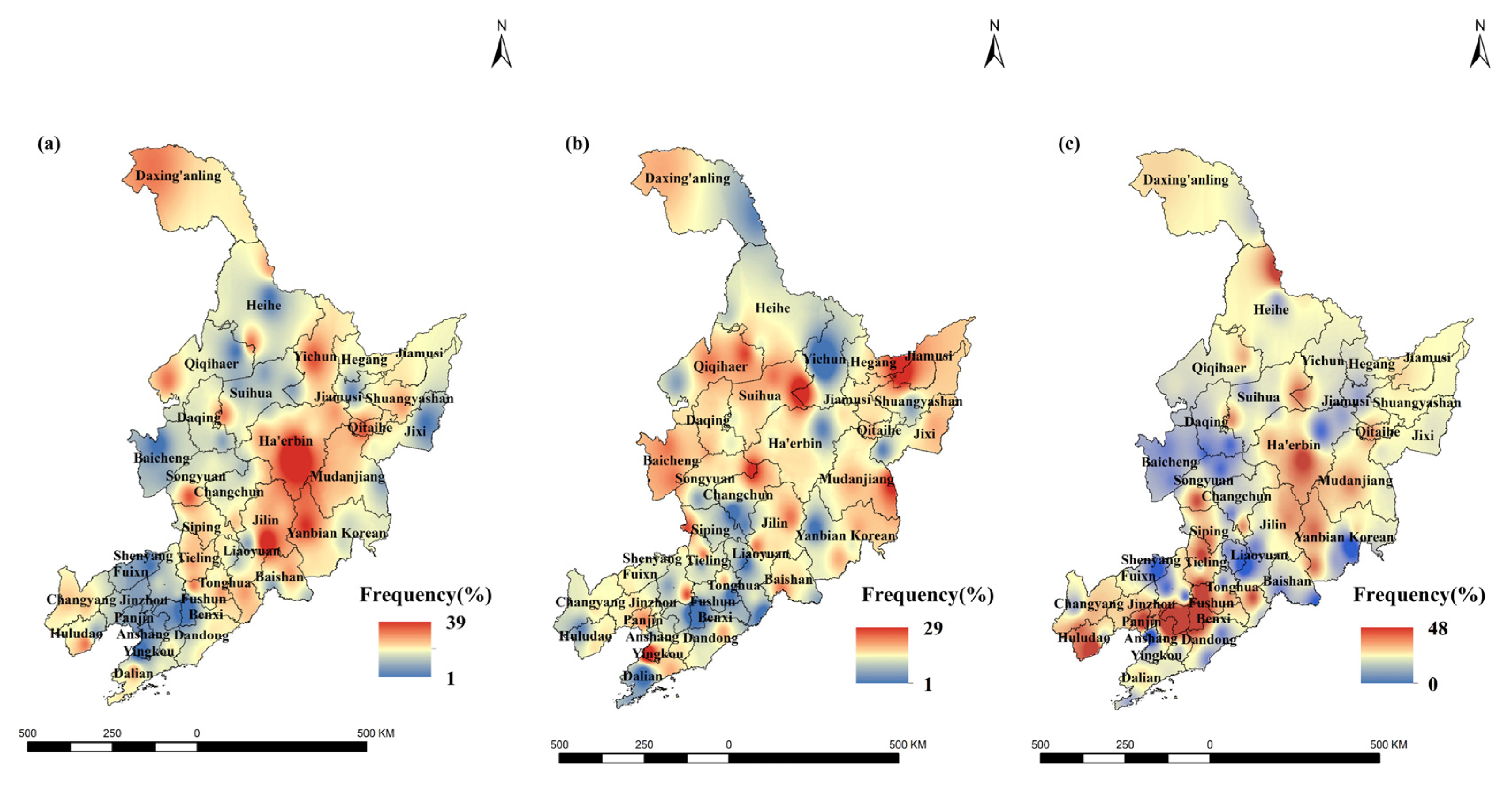
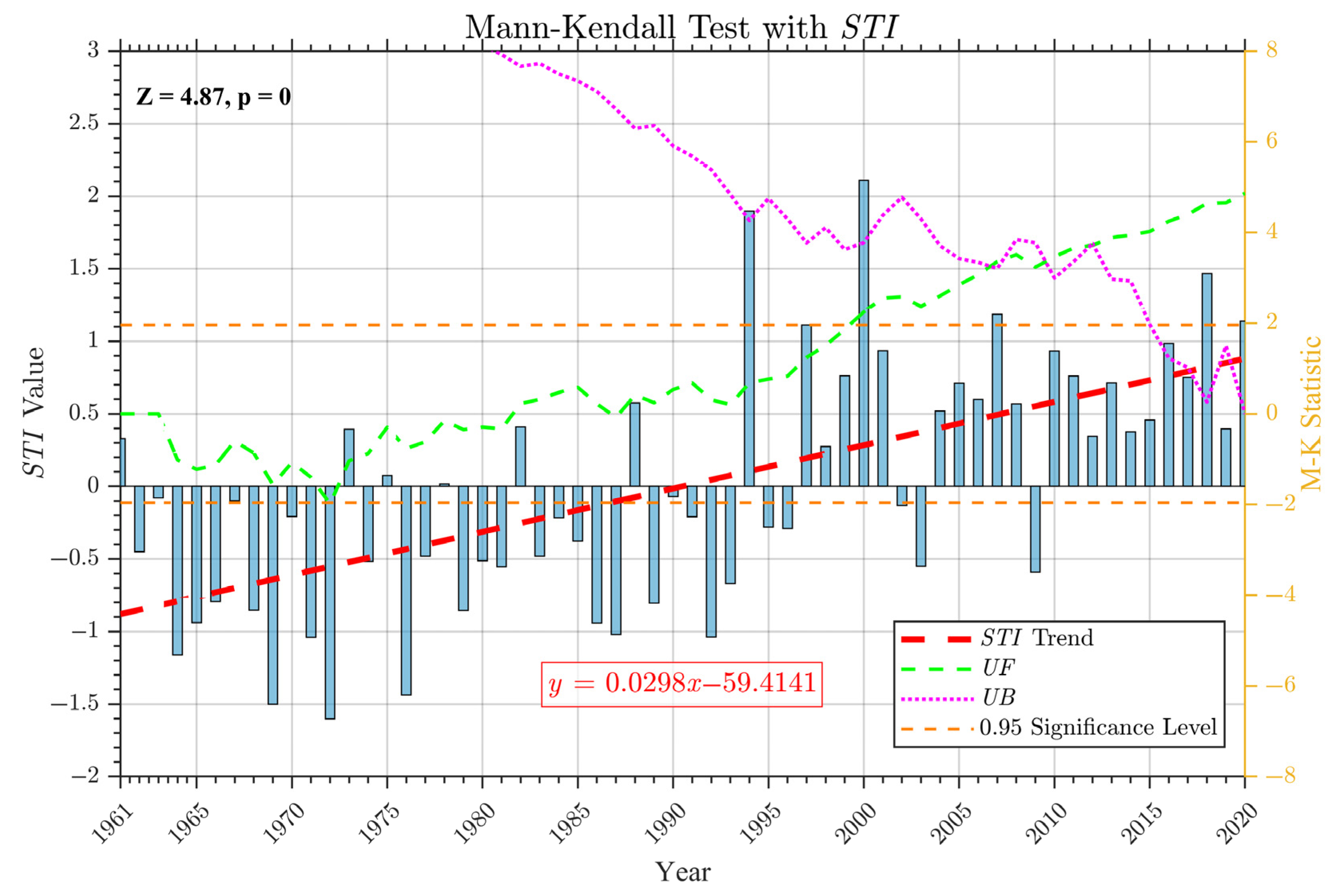
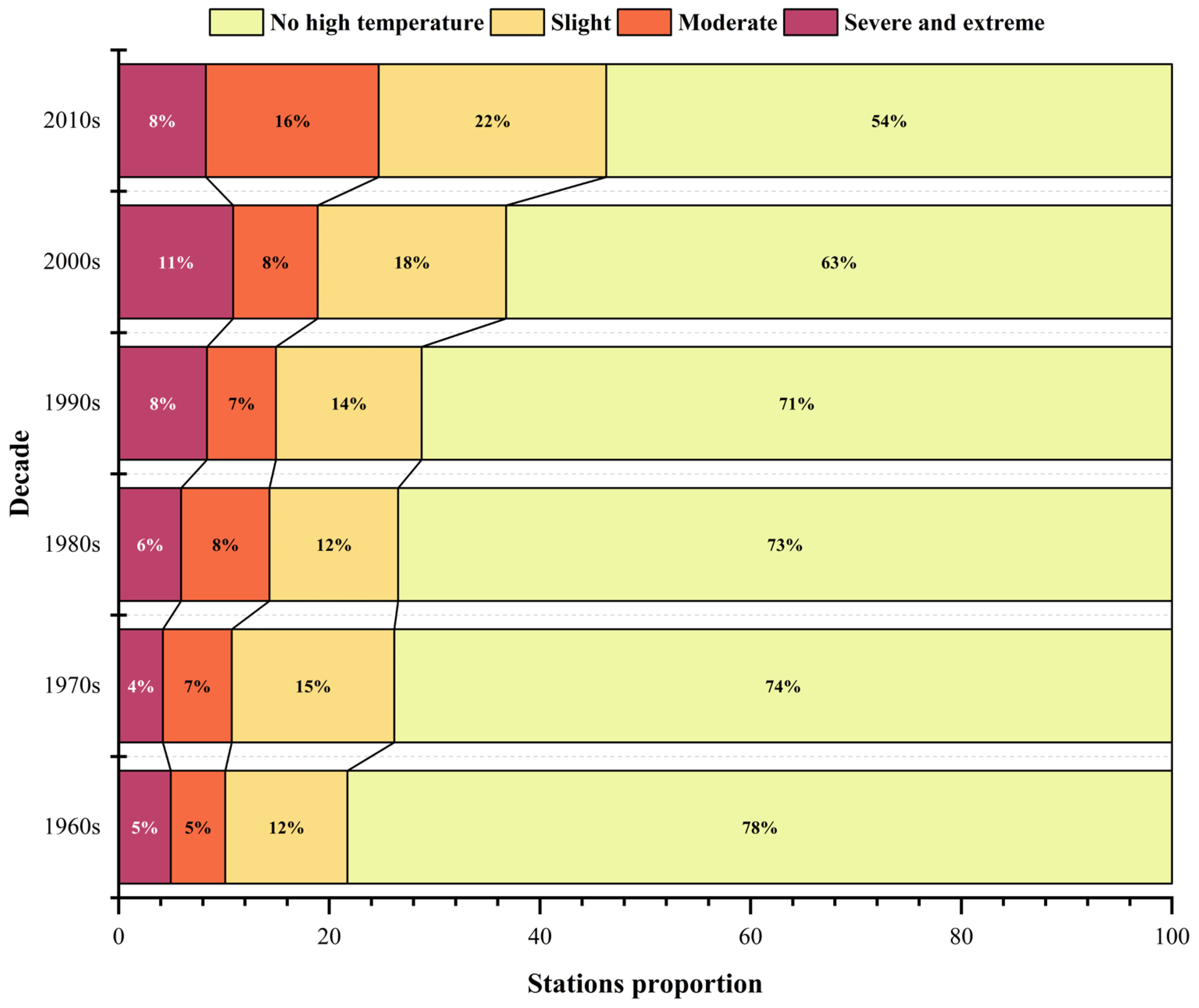
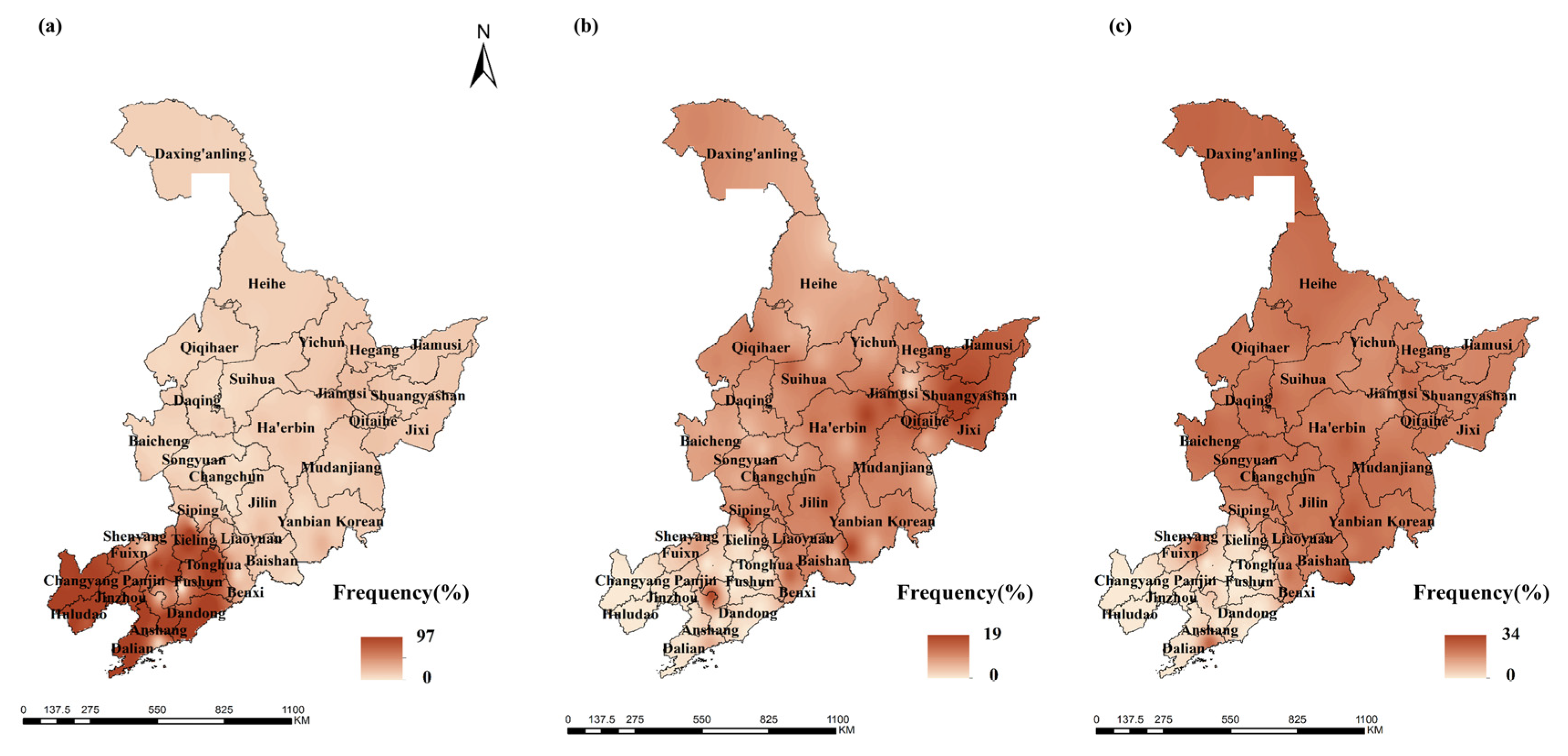
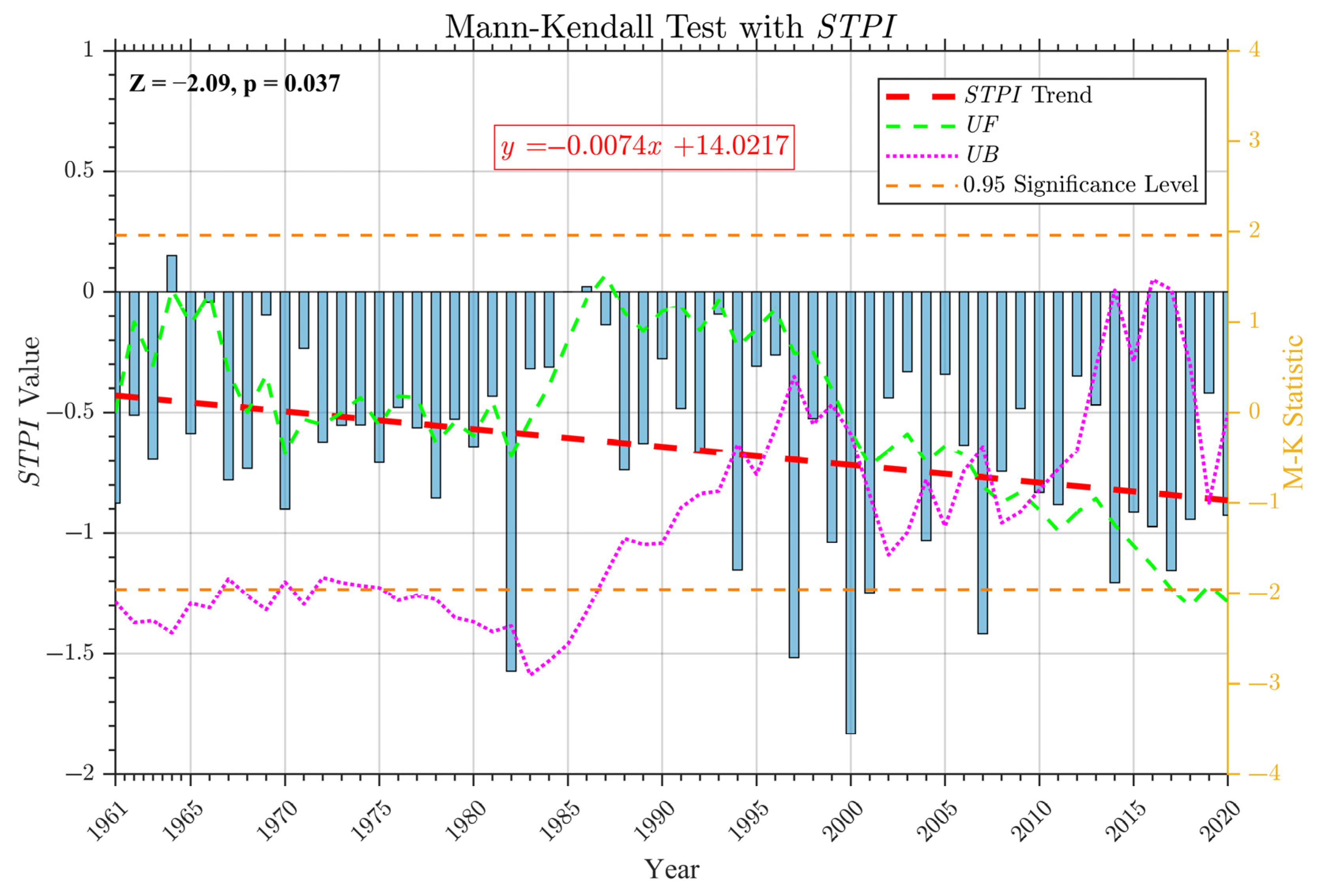

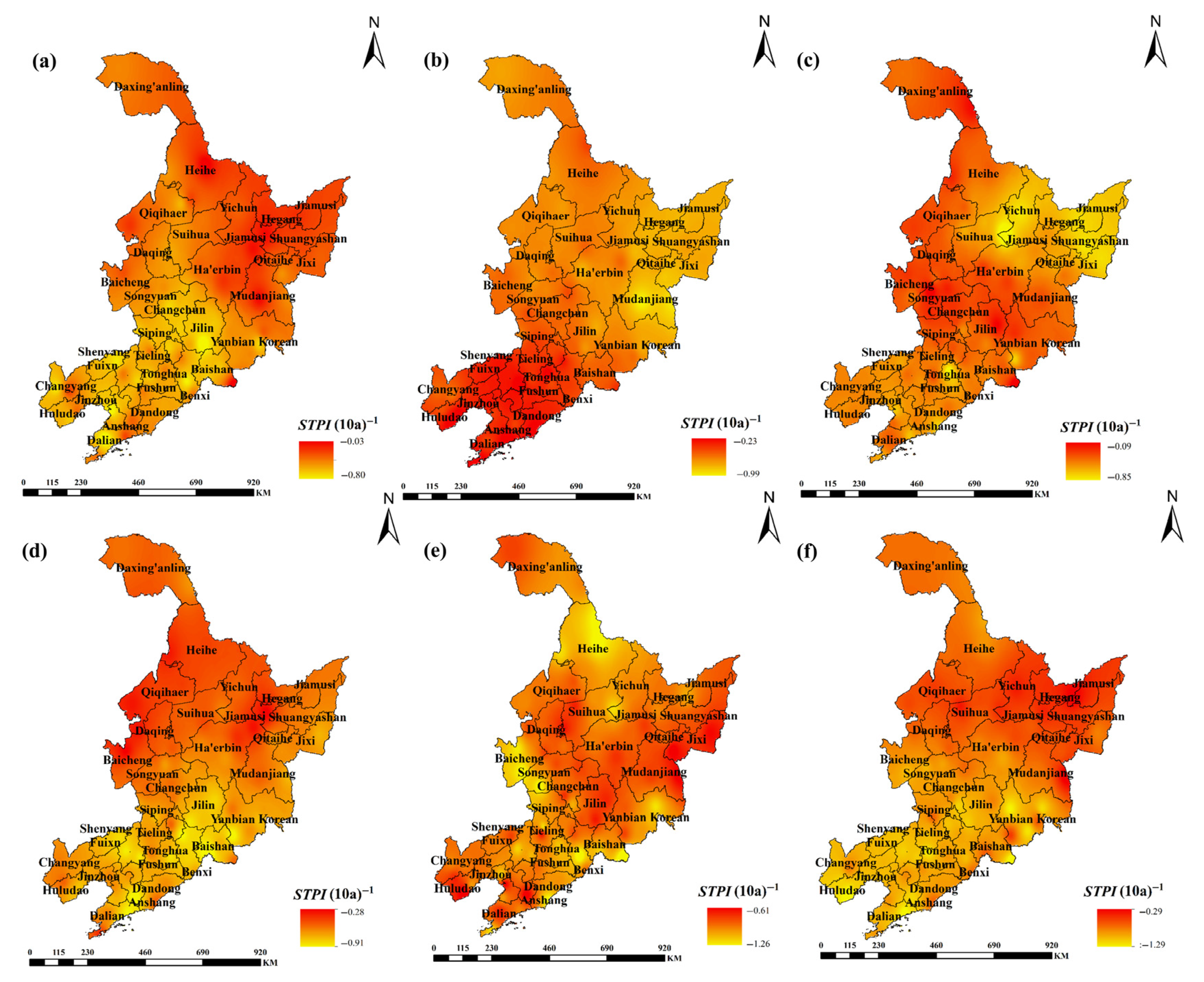


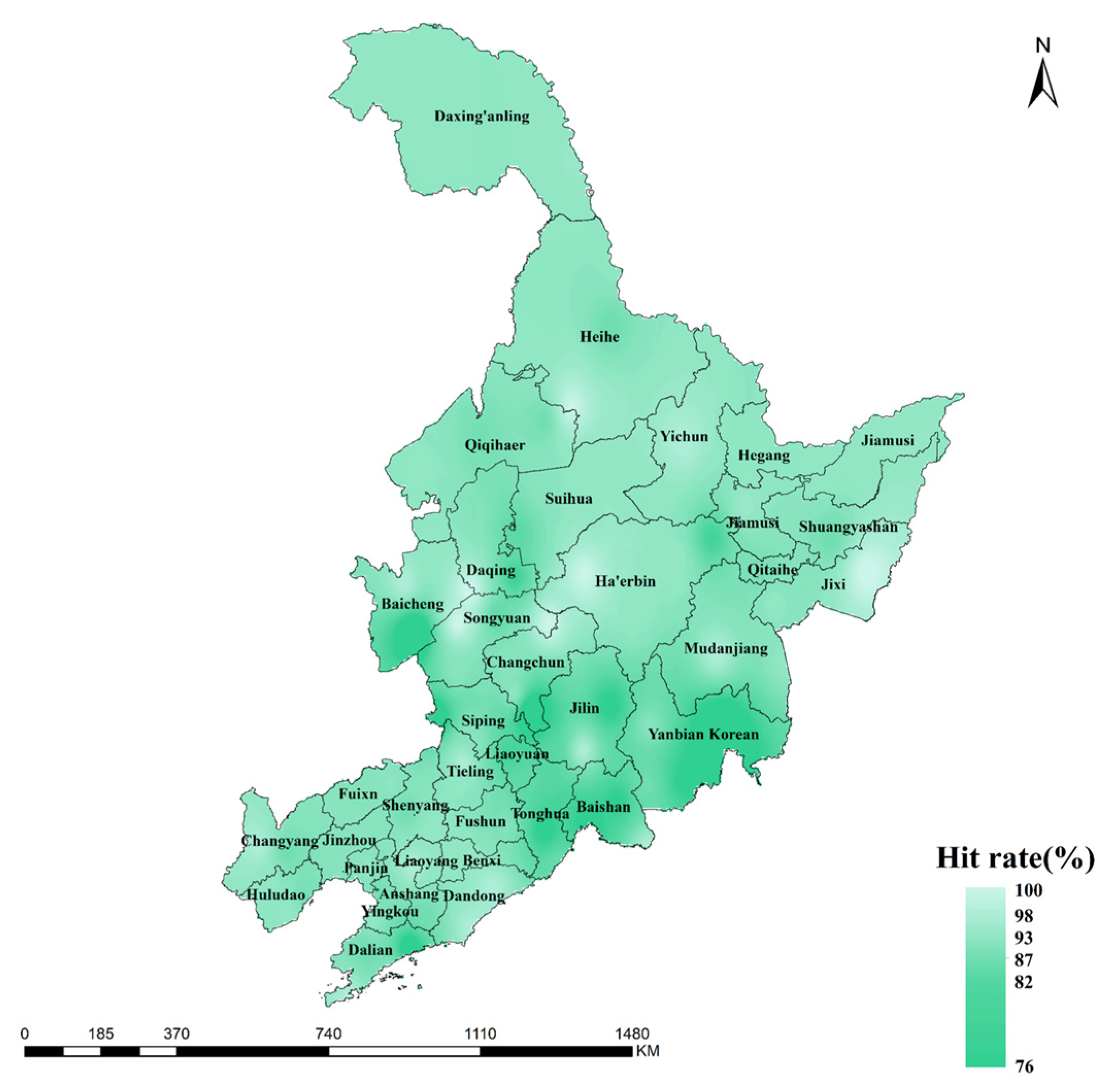
| STI | Category |
|---|---|
| 2.0 ≤ STI | Extreme heat |
| 1.5 ≤ STI < 2.0 | Severe heat |
| 1.0 ≤ STI < 1.5 | Moderate heat |
| 0.5 ≤ STI < 1.0 | Slight heat |
| SPI | Category |
|---|---|
| −1.0 ≤ SPI < −0.5 | Slight drought |
| −1.5 < SPI ≤ −1.0 | Moderate drought |
| −2.0 < SPI ≤ −1.5 | Severe drought |
| SPI ≤ −2.0 | Extreme drought |
| Copula Distribution Function | Statistical Proportion of Goodness of Fit % |
|---|---|
| Student-t | 75.6 |
| Frank | 20.3 |
| Clayton | 0 |
| Gumbel | 4.1 |
| Symmetrized Joe-Clayton | 0 |
| STPI | Category |
|---|---|
| −1 ≤ STPI | Normal |
| −1.5 ≤ STPI < −1 | Slight dry heat event |
| −2 ≤ STPI < −1.5 | Moderate dry heat event |
| −2.5 ≤ STPI < −2 | Severe dry heat event |
| STPI < −2.5 | Extreme dry heat event |
| Year | STPI | Grades | SDHI | Grades | STI | SPI |
|---|---|---|---|---|---|---|
| 1982 | −1.57 | Moderate dry heat event | −0.74 | Slight dry heat event | 0.41 | −0.74 |
| 1994 | −1.15 | Slight dry heat event | −0.43 | No dry heat event | 1.89 | 0.82 |
| 1997 | −1.51 | Moderate dry heat event | −0.77 | Slight dry heat event | 1.11 | −0.33 |
| 2004 | −1.03 | Slight dry heat event | −0.44 | No dry heat event | 0.51 | −0.57 |
Disclaimer/Publisher’s Note: The statements, opinions and data contained in all publications are solely those of the individual author(s) and contributor(s) and not of MDPI and/or the editor(s). MDPI and/or the editor(s) disclaim responsibility for any injury to people or property resulting from any ideas, methods, instructions or products referred to in the content. |
© 2025 by the authors. Licensee MDPI, Basel, Switzerland. This article is an open access article distributed under the terms and conditions of the Creative Commons Attribution (CC BY) license (https://creativecommons.org/licenses/by/4.0/).
Share and Cite
Wang, R.; Cong, L.; Sun, Y.; Bai, X. Variability of Summer Drought and Heatwave Events in Northeast China. Sustainability 2025, 17, 6569. https://doi.org/10.3390/su17146569
Wang R, Cong L, Sun Y, Bai X. Variability of Summer Drought and Heatwave Events in Northeast China. Sustainability. 2025; 17(14):6569. https://doi.org/10.3390/su17146569
Chicago/Turabian StyleWang, Rui, Longpeng Cong, Ying Sun, and Xiaotian Bai. 2025. "Variability of Summer Drought and Heatwave Events in Northeast China" Sustainability 17, no. 14: 6569. https://doi.org/10.3390/su17146569
APA StyleWang, R., Cong, L., Sun, Y., & Bai, X. (2025). Variability of Summer Drought and Heatwave Events in Northeast China. Sustainability, 17(14), 6569. https://doi.org/10.3390/su17146569






